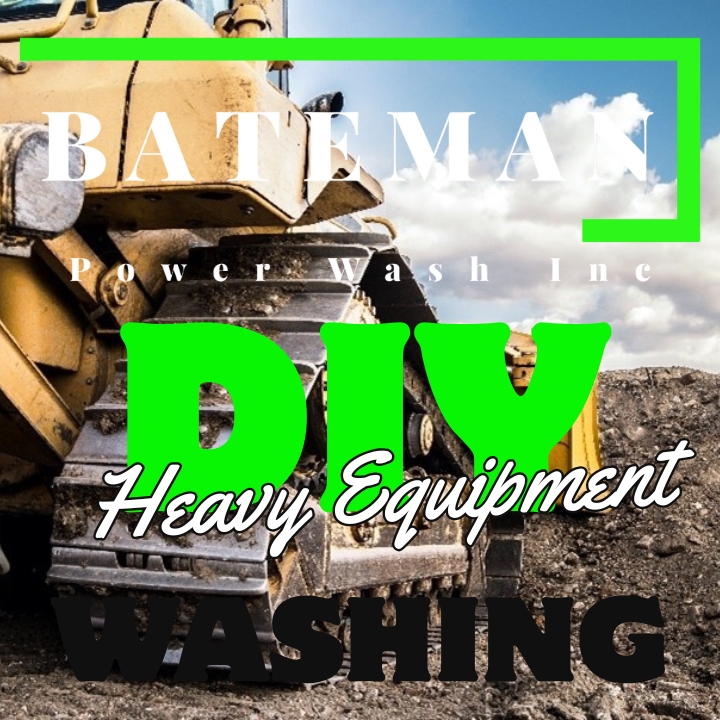Table of Contents
- Introduction: Why Heavy Equipment Needs Regular Cleaning
- Essential Equipment & Tools Checklist
- Choosing the Right Detergent (And What to Avoid)
- Pressure Washer Settings: PSI, GPM, Nozzles Explained
- Prepping the Work Area: Safety & Protection Measures
- Step-by-Step Process to Wash Heavy Equipment
- Troubleshooting Common Machinery Issues (Grease, Oil, Road Film)
- Post-Cleaning Treatments for Long-Lasting Results
- Advanced Tips: Speed, Technique, and Avoiding Damage
- Safety Protocols for Technicians
- Maintenance Schedule: How Often Should Heavy Equipment Be Washed?
- Client Education: What Operators Should Know Before & After the Service
1. Introduction: Why Heavy Equipment Needs Regular Cleaning
Heavy equipment works in tough environments — construction sites, farms, quarries, snow removal, and trucking yards. Dirt, grease, oil, and salt quickly build up. If neglected:
- Corrosion from road salt and mud reduces machine lifespan.
- Grease buildup causes overheating and fire hazards.
- Hydraulic leaks hide under dirt, delaying costly repairs.
- DOT & safety inspections require clean equipment for compliance.
Professional pressure washing not only improves appearance but also keeps equipment safe, compliant, and efficient.
2. Essential Equipment & Tools Checklist
- Pressure Washer: 4–8 GPM, 2500–4000 PSI, hot water preferred
- Nozzles:
- 25° (Green Tip) — General washing
- 15° (Yellow Tip) — Stubborn grease/oil removal
- Turbo Nozzle — Heavy mud blasting
- Detergents:
- Degreaser for oil/grease
- Salt-neutralizing detergent for winter fleets
- Brushes & Scrapers: For stuck-on mud
- Water Supply Tank (for mobile jobs)
- Safety Gear: Goggles, gloves, hearing protection, steel-toe boots
- Tarps/Plastic Sheeting: To control runoff & protect ground
3. Choosing the Right Detergent (And What to Avoid)
Ideal Cleaners:
- Biodegradable degreasers (cut through hydraulic oil, fuel, grease).
- Alkaline detergents for road film and dirt.
- Salt-neutralizers to prevent corrosion after winter jobs.
Avoid:
- Acid-based cleaners on paint (cause etching and fading).
- Harsh solvents that damage rubber seals and wiring.
DIY Mix Example:
- 1 gallon heavy-duty degreaser
- 4 gallons hot water
- Apply with soap nozzle, dwell 10–15 minutes before rinsing
4. Pressure Washer Settings: PSI, GPM, Nozzles Explained
- PSI: 2500–3500 for general cleaning; up to 4000 for heavy mud (metal only).
- GPM: 4–8 GPM for flushing out thick buildup.
- Temperature: Hot water (180–200°F) cuts grease faster.
- Nozzles:
- Turbo nozzle for tracks/undercarriage.
- 25° nozzle for painted surfaces.
- 15° nozzle for hardened grease spots.
5. Prepping the Work Area: Safety & Protection Measures
- Park equipment on level ground, away from storm drains.
- Cover sensitive electronics, intakes, and sensors.
- Pre-rinse equipment to soften mud and dirt.
- Secure ladders or use man lifts for tall machines.
- Isolate and collect runoff (contain oils/chemicals).
6. Step-by-Step Process to Wash Heavy Equipment
Step 1: Pre-Rinse
- Use high-volume water to knock off loose mud, starting at the top.
Step 2: Apply Detergent
- Spray degreaser with soap nozzle.
- Focus on greasy areas: engine bay, joints, hydraulic lines, undercarriage.
- Let dwell 10–15 minutes (don’t let it dry).
Step 3: Agitation (if needed)
- Scrub stubborn grease with nylon brush or scraper.
Step 4: Pressure Rinse
- Use 2500–4000 PSI, hot water if available.
- Clean tracks, undercarriage, wheels, radiators.
Step 5: Detail Cleaning
- Spot treat hydraulic leaks and fuel stains.
- Rinse thoroughly to avoid detergent residue.
7. Troubleshooting Common Machinery Issues
| Problem | Solution |
|---|---|
| Grease buildup won’t release | Increase dwell time or use hot water + degreaser |
| Oil stains remain | Apply solvent-based degreaser, scrub, then rinse |
| Salt corrosion | Use salt-neutralizer rinse |
| Mud packed into undercarriage | Use turbo nozzle + scraper |
8. Post-Cleaning Treatments for Long-Lasting Results
- Apply rust inhibitor to exposed metal.
- Lubricate grease fittings after cleaning (washing removes lubrication).
- Use protective wax or coating on painted surfaces.
- Consider undercarriage sealant for snowplows and winter equipment.
9. Advanced Tips: Speed, Technique, and Avoiding Damage
- Always work top-down for efficiency.
- Use long-range nozzles to clean tall machinery safely from the ground.
- Avoid direct spray on electrical components and bearings.
- Pre-soak heavily soiled machines to cut wash time in half.
10. Safety Protocols for Technicians
- Wear PPE: goggles, gloves, boots, hearing protection.
- Keep hoses organized to avoid tripping hazards.
- Use man lifts or safety harnesses for tall equipment.
- Ensure hot water washers are vented to avoid burns.
11. Maintenance Schedule: How Often Should Heavy Equipment Be Washed?
| Environment | Frequency |
|---|---|
| Construction Sites | Weekly |
| Farms / Agricultural Equipment | Every 2–3 Weeks |
| Winter Road Equipment (Snowplows, Salt Spreaders) | Daily–Weekly |
| Quarry & Mining Equipment | Weekly–Biweekly |
12. Client Education: What Operators Should Know
Before Service:
- Remove personal items from cabs.
- Secure covers over sensitive electronics.
- Ensure water hookup (if not mobile).
After Service:
- Re-lubricate joints & fittings.
- Inspect for leaks now visible after wash.
- Schedule regular cleanings for compliance & longevity.

